Ten Steps Used To Make
Steel Pans (Steel Drums)
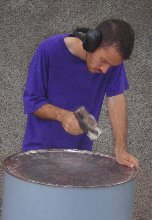 |
STEP 1 - SINKINGEmpty 55 gallon drums (17 or 18-gauge steel) are used to make steel pans. First, the top of the drum is stretched to create enough space for the notes. A sledge hammer (with a sawed off handle) is used to stretch the metal into a concave shape. The depth to which the drum is sunk depends on the type of steel pan being made. |
STEP 2 - MARKINGTemplates cut in the shape of the notes of a finished steel pan, are placed on the stretched surface of the drum and outlined using a pencil, chalk etc. This ensures that the placement of the notes on the pan is correct and consistent. |
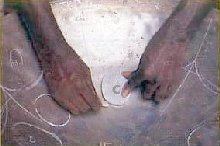 |
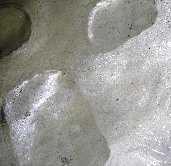 |
STEP 3 - COUNTER-SINKINGThe area in between the note outlines is flattened using special tuning hammers. This forces the notes to protrude slightly and take on a convex shape. |
STEP 4 - GROOVINGIndentations are then placed on the note outlines. This process is known as grooving. The indentations or grooves are created using a nail punch struck by a hammer. Some steel pan tuners claim this process creates an area of 'dead' metal around each note. This is supposed to prevent the sound of one note from bleeding into another when the steel pan is being played. However, other pan tuners believe grooving is purely aesthetic. There has been some experimentation with grooveless pans but most tuners make steel pans with grooves. |
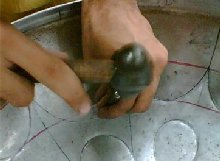 |
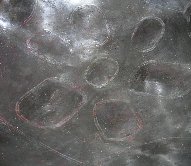 |
STEP 5 - SETTING/BACKINGThe area in between the notes is flattened again to remove any bumps or unevenness that developed during the grooving process. |
STEP 6 - CUTTINGThe skirt (side) of the drum is measured and unwanted portions of the drum shell removed. The skirts of pans serve several acoustic functions and its length depends on the type of pan being made. An electric saw or sometimes a hammer and chisel is used to cut the shell. |
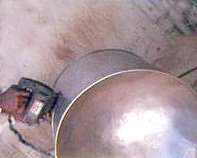 |
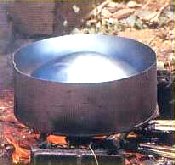 |
STEP 7 - BURNINGThe metal is tempered by rapidly heating and cooling the drum. Tempering the drums make steel pans hold their tuning for longer periods. The drum is placed with the playing surface down, over a fire and heated until the metal turns blue. It is then cooled by pouring water over it or is simply left to cool naturally. |
STEP 8 - TUNINGAfter the drum has cooled, the tuning process begins. Small tuning hammers are used to tap both the underside and the tops of notes until the correct pitch is achieved. This is a complex art! Pan tuners have to place the correct combination of overtones and fundamentals around each note. This ensures that the correct pitch and timbral quality is achieved. Strobe tuners are used to ensure the integrity of this process. |
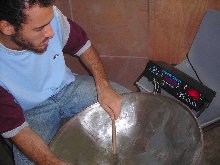 |
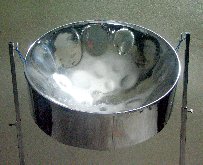 |
STEP 9 - APPLYING A PROTECTIVE FINISHAfter tuning, a protective finish is added to the pan to prevent rusting. The most common finishes are chrome plating, painting and more recently powder coating. Protective finishes also make steel pans more attractive. This picture is an example of a chrome plated steel pan. |
STEP 10 - FINE TUNING AND BLENDING
The pan is then fine tuned. The pitches on the pan must be in tune with each other.
After this, it is blended with the other pans in the steelband. This means that the tonal quality and the pitches of the pan are matched with that of the other instruments in the steelband.
Special tuning hammers are used to tap both the underside and the tops of notes until the correct pitch and timbre is achieved.
Frequent use will make steel pans go out of tune. There is no avoiding it. The fine tuning and blending process has to be repeated several times over the life of the steel pan.
Contact a trained professional to tune and blend your instruments. Don't try to tune them yourself.
The following video is quite old and some of the equipment is outdated BUT you can still see clearly some of the steps used to make a steel pan.